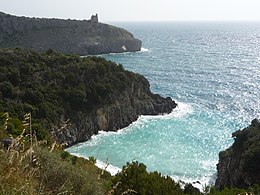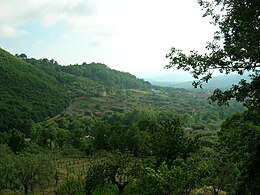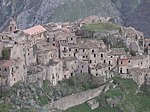| UNESCO World Heritage Site | |
|---|---|
 The coast of Cilento nearby Marina di Camerota The coast of Cilento nearby Marina di Camerota | |
| Location | Province of Salerno, Campania, Italy |
| Part of | Cilento and Vallo di Diano National Park with the Archeological Sites of Paestum and Velia, and the Certosa di Padula |
| Criteria | Cultural: (iii)(iv) |
| Reference | 842 |
| Inscription | 1998 (22nd Session) |
| Coordinates | 40°17′24″N 15°28′34″E / 40.290°N 15.476°E / 40.290; 15.476 |
  | |

Cilento (Italian: [tʃi.len.to]) is an Italian geographical region of Campania in the central and southern part of the province of Salerno and an important tourist area of southern Italy.
Cilento is known as one of the centers of Mediterranean diet.
Geography
The coast of Cilento is located on the Tyrrhenian Sea, stretching from Paestum to the Gulf of Policastro, near the town of Sapri. Most of the touristic destinations in the coast are frazioni (hamlets) of comuni (municipalities) whose seats are inland; examples include Santa Maria di Castellabate, Acciaroli, Velia, Palinuro, Marina di Camerota, Scario and Policastro Bussentino.
The inner boundaries are the Alburni mountains and Vallo di Diano, sometimes considered as part of Cilentan geographical region, which has in Sala Consilina its largest center. The most important towns in this area are Vallo della Lucania (in the middle), Sapri and Agropoli: this is the largest town of Cilento and the principal harbour. Most of this area is included in "Cilento and Vallo di Diano National Park".
Inland communes
Moio Della Civitella
- Montano Antilia
- Monte Cicerale
- Monteforte Cilento
- Morigerati
- Ogliastro Cilento
- Omignano
- Ottati
- Piaggine
- Salento, Cilento
- Sessa cilento
- Prignano Cilento
- Rutino
- Sacco
- Stio
- Torchiara
- Tortorella
- Trentinara
- Vallo della Lucania
Seaside Communes
- Agropoli
- Ascea
- Camerota
- Capaccio
- Caprioli
- Casal Velino
- Castellabate
- Centola
- Montecorice
- Palinuro
- Pisciotta
- Pollica
- San Giovanni a Piro
- San Mauro Cilento
- Sapri
History
Greek colonies
The region is steeped in Greek mythology and legends, as in the names of some towns, which is also visible in the remains of the colonies of Velia (ancient Elea) and Paestum (ancient Poseidonia). Velia was also the seat of "Eleatics", a school of pre-Socratic philosophers as Parmenides, Zeno of Elea and Melissus of Samos).
Cilento comes by the Latin word Cis Alentum, meaning "On this side of the Alento".
Sixth province of Campania
In the 1990s it was proposed to make Cilento a new province of Campania. This proposal has never come near to implementation; in particular there was the difficulty of choosing an administrative centre. The four candidates were Vallo della Lucania (in the most central position), Agropoli (the largest town, situated in the north), Sala Consilina (the most populous town of Vallo di Diano) and Sapri (in the centre of southern Cilento, with the most important railway station). Another more recent proposal was to move Cilento from Campania to Basilicata, as a third province together with the existing provinces of Potenza and Matera.
National Park
Main article: Cilento and Vallo di Diano National ParkIn 1991, Cilento and Vallo di Diano National Park was instituted to preserve the landscape and promote tourism. In 1998, the park became a World Heritage Site of UNESCO.
Coast
Main article: Cilentan CoastThe Cilentan Coast, or Costiera Cilentana in Italian, is a stretch of coastline situated in the gulfs of Salerno and Policastro, extending in 16 municipalities; from Capaccio-Paestum in the north-west to Sapri in the south-east.
Language
Main article: Cilentan languageCilento was part of ancient Lucania, and its language is influenced by Lucanian. In the north of Cilento the dialect is more influenced by Neapolitan, but in the south it has many similarities with Sicilian.
Cilento DOC
Italian wine, red, white and rose, under the Cilento DOC appellation comes from this area. Grapes destined for DOC product must be harvested to a maximum yield of 12 tonnes/hectare with the finished red wines fermented to a minimum alcohol level of 11.5% and the whites and roses fermented to 11%.
Red Cilento wines are a blend of 60-70% Aglianico, 15-20% of Piedirosso and/or Primitivo, 10-20% Barbera and up to 10% of other local red grape varieties. The whites are a blend of 60-65% Fiano, 20-30% Trebbiano, 10-15% of Greco and/or Malvasia bianca with up to 10% of other local white varieties. The roses are blends of 70-80% Sangiovese, 10-15% of Piedirosso and/or Primitivo and up to 10% of other local red grape varieties. A separate varietal Aglianico can also be produced under the Cilento DOC provided that at least 85% of the wine is Aglianico with Primitivo and/or Piedirosso permitted to fill in the remainder and that the wine is aged at least one year before it is released.
Photogallery
-
Agropoli
-
 Velia
Velia
-
 Licosa island in the Comune of Castellabate
Licosa island in the Comune of Castellabate
-
Paestum
-
 Paestum
Paestum
-
 Romagnano al Monte
Romagnano al Monte
-
 S.Maria di Castellabate
S.Maria di Castellabate
-
 Cape Palinuro
Cape Palinuro
See also
- Cilento and Vallo di Diano National Park
- Vallo di Diano
- Velia ("Elea")
- Paestum ("Poseidonia")
- Pruno Cilento
- Cilentan language
- Gulf of Salerno
- Agropoli
- Vallo della Lucania
- Sapri
- Sala Consilina
- Marina di Camerota
- Certosa di Padula (Padula)
- Cape Palinuro (Palinuro)
References
- "Cis Alentum: The origin of the name "Cilento"". Archived from the original on September 22, 2018.
- "Rassegna Stampa" [Press Review]. Il Mattino, www.oricchio.it. 14 November 2001. Retrieved 26 September 2022.
- "L'area comprende il Vallo di Diano, il Cilento e il Golfo di Policastro «Via dalla Campania, entriamo in Basilicata»" [The area includes the Vallo di Diano, Cilento and the Gulf of Policastro "Via the Campania, let's enter Basilicata"]. Corriere della Sera (in Italian). Retrieved 26 September 2022.
- ^ Saunders, P. (2004). Wine Label Language. Firefly Books. p. 139. ISBN 1-55297-720-X.
Sources
- Maurizio Tortora: Cilientu mia. Edizione del Delfino, 1977, Naples
- Giuseppe Vallone: Dizionarietto etimologico del basso Cilento. Editore UPC, 2004
- Pietro Rossi: Ieri e oggi 1955-2005. Poesie in cilentano. Grafiche Erredue, 2005
- Barbara Schäfer: Limoncello mit Meerblick. Unterwegs an der Amalfiküste und im Cilento. Picus, 2007, ISBN 978-3-85452-924-8
- Peter Amann: Cilento aktiv mit Costa di Maratea - Aktivurlaub im ursprünglichen Süditalien. Mankau, 2007, ISBN 3-938396-08-3
- Peter Amann: Golf von Neapel, Kampanien, Cilento. Reise Know-How, 2006, ISBN 3-8317-1526-2
- Barbara Poggi: La Cucina Cilentana - Köstlichkeiten aus der Cilento-Küche. Mankau, 2006, ISBN 3-938396-02-4
- Luciano Pignataro: Le ricette del Cilento. Ed. Ippogrifo, 2007, ISBN 978-88-88986-43-2
External links
- What to do and see in Cilento and Tourism in Cilento (in Italian)
- Cilento and Vallo di Diano National Park (in Italian and English)
- Historical and other infos about Cilento and Vallo di Diano National Park (in English)
- Cilento Photos (in English)
- Tourism in the National park of Cilento (in Italian)
- Tourism and holidays in Cilento (in Italian)
- Cilento Social Network (in Italian)
| Provinces |  | |
|---|---|---|
| Places | ||
| History | ||
| Politics and government | ||
| Culture | ||
| Categories | ||